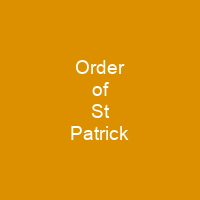The Most Illustrious Order of Saint Patrick is a dormant British order of chivalry associated with Ireland. The Order was created in 1783 by George III at the request of the then Lord Lieutenant of Ireland, the 3rd Earl Temple. No knight of St Patrick has been created since 1936, and the last surviving knight, Prince Henry, Duke of Gloucester, died in 1974.
About Order of St Patrick in brief

The British Government continued to entertain hopes for the Order’s revival as a pan-Irish institution, but it chose not to do so. Since then, only three people have been appointed to it, all members of the British Royal Family. It is likely that these appointments were considered possible because the Irish free state continued to recognise the British monarch as its official head of state. The Scottish equivalent is the Most Ancient and Most Noble Order of the Thistle, dating in its present form from 1687. The order was founded a year after the grant of substantial autonomy to Ireland, as a means of rewarding political support in the Irish Parliament. The statutes of theorder restricted membership to men who were both knights and gentlemen, the latter being defined as having three generations of \”noblesse\” on both their father’s and mother’s side. One of the first knights was the 2nd Duke of Leinster, whose arms carry the same cross. In 1907, its insignia, known generally as the Irish Crown Jewels, were stolen from the Bedford Tower in Dublin Castle, shortly before a visit by King Edward VII. Their whereabouts remain a mystery. The Order of StPatrick earned international coverage when, in 1907, their insignia were stolen. A flag of this design was later incorporated into the Union Flag, but its association with St Patrick or with Ireland prior to its foundation is unclear, however.
You want to know more about Order of St Patrick?
This page is based on the article Order of St Patrick published in Wikipedia (as of Dec. 03, 2020) and was automatically summarized using artificial intelligence.







